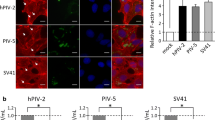Summary
Rubella virus (RV)-host cell interactions were examined by indirect immunofluorescence staining using antibodies to viral products and cytoskeletal components as probes. The patterns of immunofluorescence observed with human convalescent sera indicated that in infected Vero cells RV-specified proteins were distributed throughout the rough endoplasmic reticulum with some possible accumulation in the region of the Golgi complex. Viral RNA synthesis, detected with anti-double stranded RNA, appeared to be confined to small, intensely stained foci irregularly distributed in the cytoplasm. When cells were infected at a higher multiplicity, these foci appeared to aggregate into linear arrays. Infection with RV had a profound effect on the organization of actin in both Vero and BHK 21 cells, as shown by anti-actin antibodies. Actin microfilaments were observed to disintegrate progressively into amorphous aggregates of apparently monomeric actin as the infection proceeded. Because of the role actin microfilaments may play in cell mitosis it is postulated that this effect may be related to the inhibition of cell division reported to be associated with the congenital rubella syndrome.
Similar content being viewed by others
References
Alberts B, Bray D, Lewis J, Raff M, Roberts K, Watson JD (1983) The cytoskeleton. In: Molecular biology of the cell. Garland Publishing, New York, pp 549–609
Bardeletti G (1977) Respiration and ATP levels in BHK 21/13 S cells during the earliest stages of rubella virus replication. Intervirology 8: 100–109
Bowden DS, Westaway EG (1984) Rubella virus: structural and non-structural proteins. J Gen Virol 65: 933–943
Cooper LZ (1985) The history and medical consequences of rubella. Rev Infect Dis [Suppl 1] 7: 3–10
Fagreus A, Tyrrell DLJ, Norberg R, Norrby E (1978) Actin filaments in paramyxovirus-infected human fibroblasts studied by indirect immunofluorescence. Arch Virol 57: 291–296
Green J, Griffiths G, Louvard D, Quinn P, Warren G (1981) Passage of viral membranes through the Golgi complex. J Mol Biol 152: 663–698
Gregg NM (1941) Congenital cataract following german measles in the mother. Trans Ophthalmol Soc Aust 3: 35–46
Grimley PM, Levin JG, Berezesky IK, Friedman RM (1972) Specific membranous structures associated with the replication of group A arboviruses. J Virol 10: 492–503
Heggie AD (1977) Growth inhibition of human embryonic and fetal rat bones in organ culture by rubella virus. Teratology 15: 47–56
Herrmann KL (1979) Rubella virus. In:Lennette EH, Schmidt NJ (eds) Diagnostic procedures for viral, rickettsial and chlamydial infections. American Public Health Association, Washington, pp 725–766
Lewin B (1980) Cell structure and genetics. In: Gene expression 2: eucaryotic chromosomes, 2nd edn. John Wiley, New York, pp 11–70
Lösse D, Lauer R, Weder D, Radsak K (1982) Actin distribution and synthesis in human fibroblasts infected by cytomegalovirus. Arch Virol 71: 353–359
Luftig RB (1982) Does the cytoskeleton play a significant role in animal virus replication? J Theor Biol 99: 173–191
Mathy JP, Baum R, Toh BH (1980) Autoantibodies to ribosomes and Systemic lupus erythematosis. Clin Exp Immunol 41: 73–80
Ng ML, Pedersen JS, Toh BH, Westaway EG (1983) Immunofluorescent sites in Vero cells infected with the flavivirus Kunjin. Arch Virol 78: 177–190
Pettersson RF, Oker-Blom C, Kalkkinen N, Kallio A, Ulmanen I, Kääriäinen L, Partanen P, Vaheri A (1985) Molecular and antigenic characteristics and synthesis of rubella virus structural proteins. Rev Infect Dis [Suppl 1] 7: 140–149
Plotkin SJ, Vaheri A (1967) Human fibroblasts infected with rubella virus produce a growth inhibitor. Science 156: 659–661
Plotkin SJ, Boué A, Boué JG (1966) Thein vitro growth of rubella virus in human embryo cells. Am J Epidem 81: 71–85
Rawls WE, Melnick JL (1966) Rubella virus carrier cultures derived from congenitally infected infants. J Exp Med 123: 795–816
Rutter G, Mannweiler K (1977) Alterations to actin-containing structures in BHK-21 cells infected with Newcastle disease virus and vesicular stomatitis virus. J Gen Virol 37: 233–242
Saraste J, Kuismanen E (1984) Pre- and post-Golgi vacuoles operate in the transport of Semliki Forest virus membrane glycoproteins to the cell surface. Cell 38: 535–549
Sedwick WD, Sokol F (1970) Nucleic acid of rubella virus and its replication in hamster kidney cells. J Virol 5: 478–489
Stollar BD, Stollar V (1970) Immunofluorescent demonstration of double-stranded RNA in the cytoplasm of Sindbis virus-infected cells. Virology 42: 276–280
Vaheri A, Cristofalo VJ (1967) Metabolism of rubella virus-infected BHK 21 cells. Enhanced glycolysis and late cellular inhibition. Arch Ges Virusforsch 21: 425–436
Waxham MN, Wolinsky JS (1985) Detailed immunologic analysis of the structural polypeptides of rubella virus using monoclonal antibodies. Virology 143: 153–165
Wong KT, Robinson WS, Merigan TC (1969) Synthesis of viral-specific ribonucleic acid in rubella virus-infected cells. J Virol 4: 901–903
Woods, WA, Johnson RT, Hostetler DD, Lepow ML, Robbins FC (1966) Immunofluorescent studies on rubella-infected tissue cultures and human tissues. J Immunol 96: 253–260
Author information
Authors and Affiliations
Additional information
With 3 Figures
Rights and permissions
About this article
Cite this article
Bowden, D.S., Pedersen, J.S., Toh, B.H. et al. Distribution by immunofluorescence of viral products and actin-containing cytoskeletal filaments in rubella virus-infected cells. Archives of Virology 92, 211–219 (1987). https://doi.org/10.1007/BF01317478
Received:
Accepted:
Issue Date:
DOI: https://doi.org/10.1007/BF01317478




